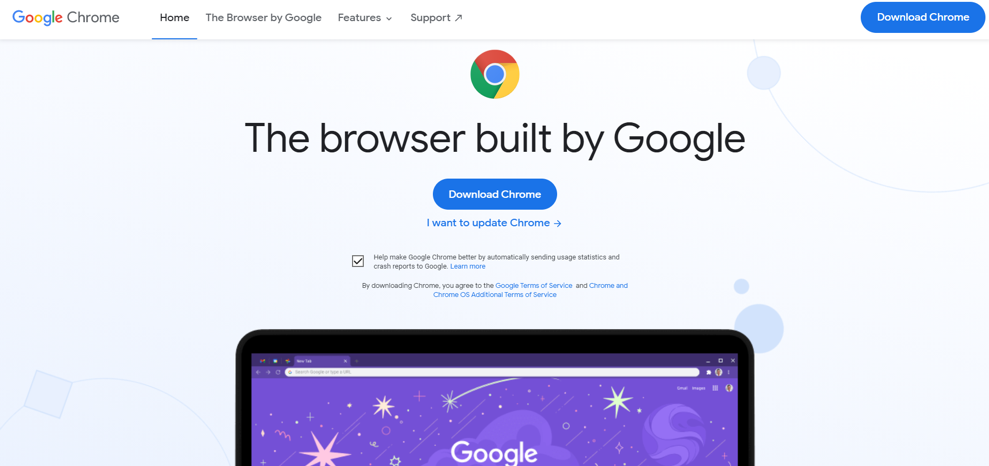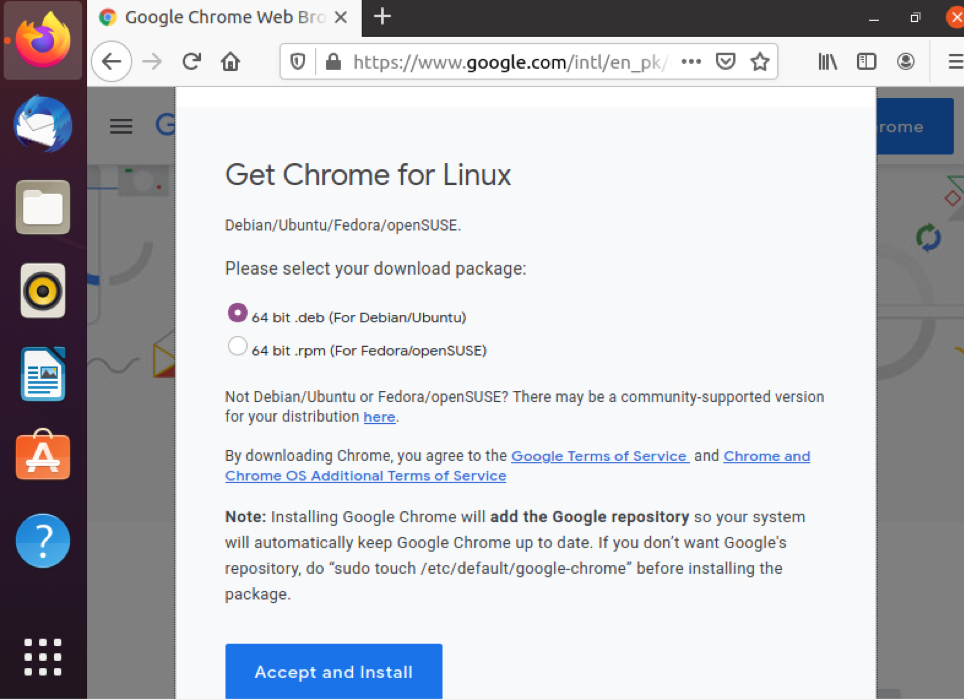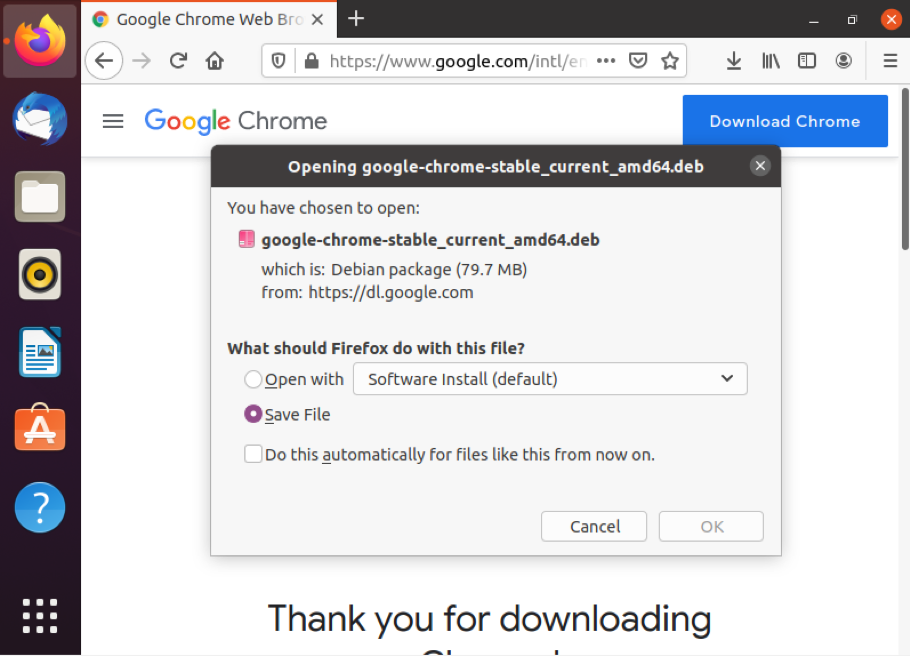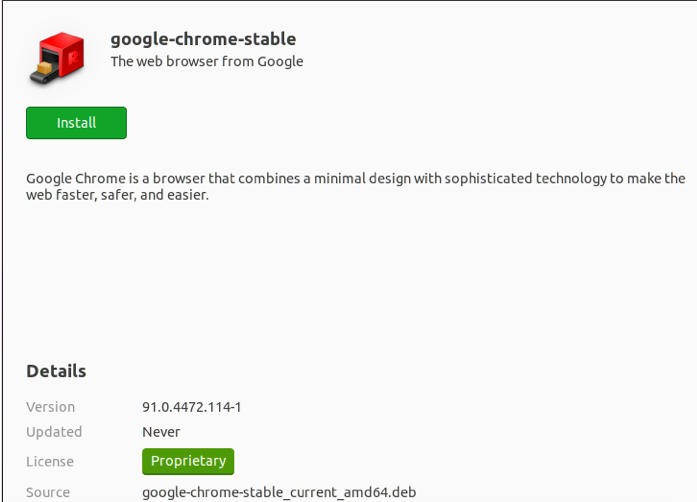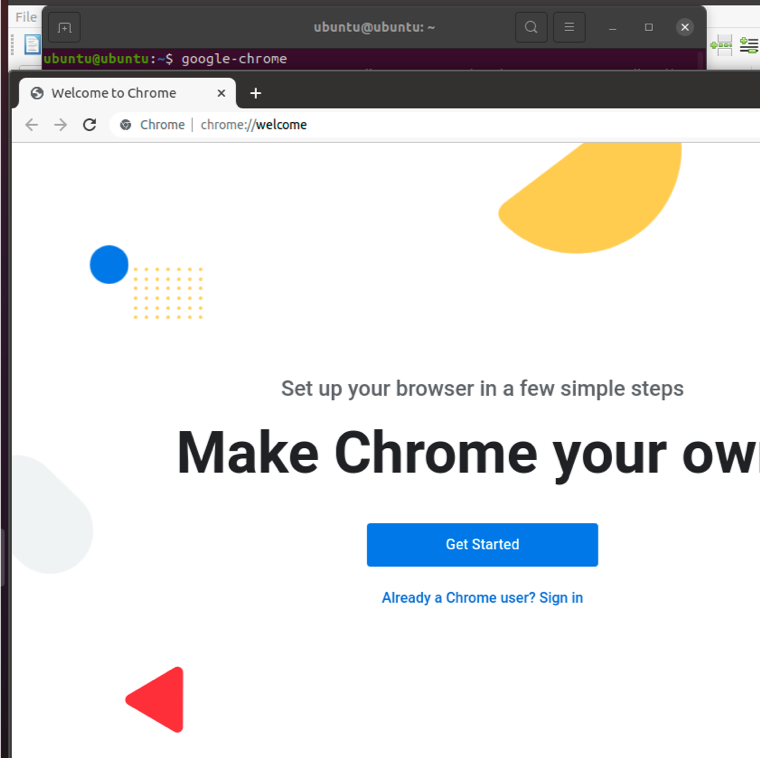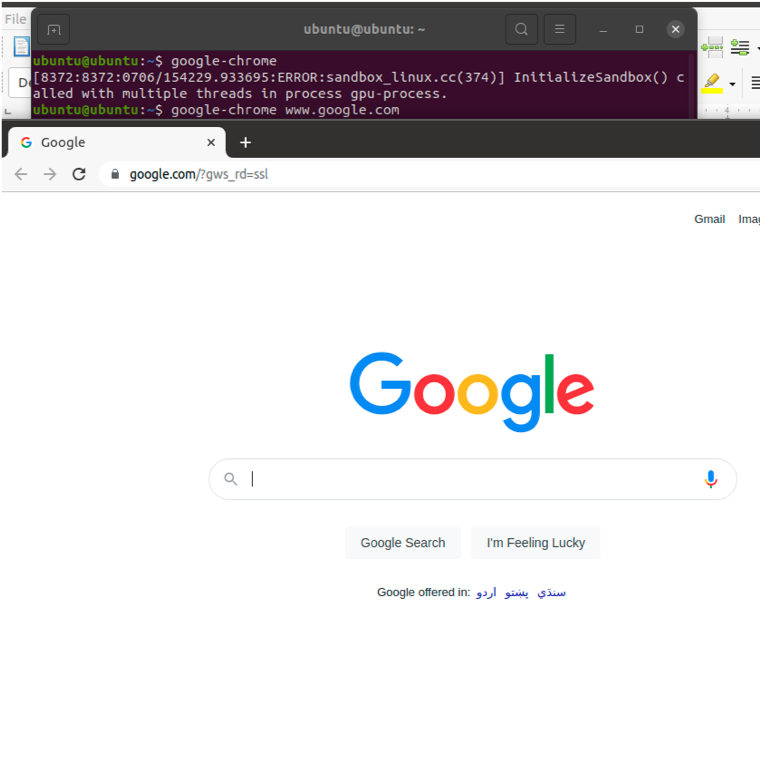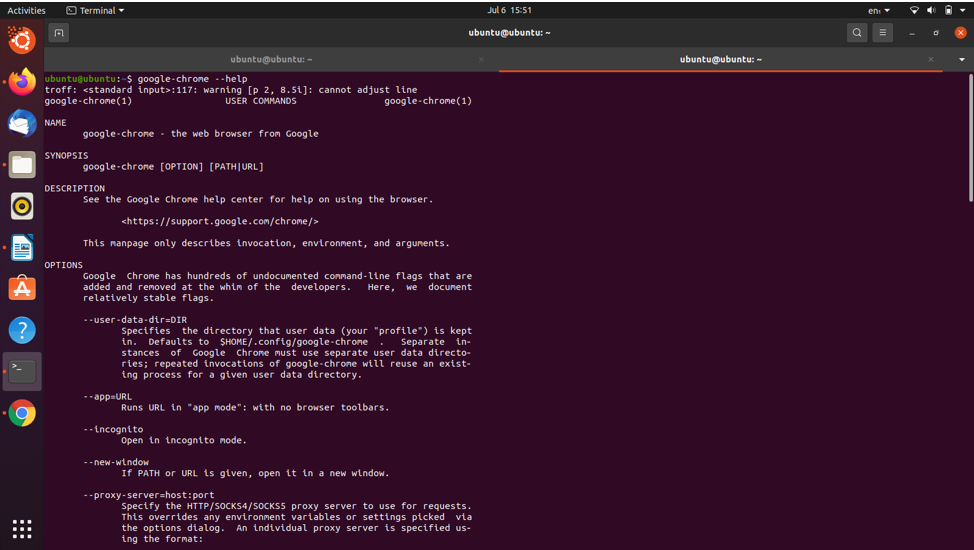How to install Chrome browser properly via command line?
And then «Y» for the Y/n question. But the installation threw errors. Does someone see anything wrong with the commands I issued?
7 Answers 7
Google Chrome is not in the repositories because it is proprietary, however Chromium(the open source platform Chrome is built upon) is.
These are the instructions to install Chrome on a 64 bit Linux distribution as that architecture is the only one Chrome supports.
To install Google Chrome, run the following:
sudo apt-get install libxss1 libappindicator1 libindicator7 wget https://dl.google.com/linux/direct/google-chrome-stable_current_amd64.deb sudo apt install ./google-chrome*.deb If error messages pop up after running the command sudo apt install ./google-chrome*.deb then run the command
I get this an ERROR 404 with these instructions. I installed using @David E. Moore instructions listed below. Not sure if adding the libxss1 helped with Mr Moore’s instruction or not but I did do that before. This was on a fresh install on 13.10 Unity amd64 install.
wget -q -O - https://dl-ssl.google.com/linux/linux_signing_key.pub | sudo apt-key add - sudo sh -c 'echo "deb https://dl.google.com/linux/chrome/deb/ stable main" >> /etc/apt/sources.list.d/google.list' sudo apt-get update sudo apt-get install google-chrome-stable after following the steps, when i run the command sudo apt-get install google-chrome-stable, «Unable to locate package google-chrome-stable»
Perhaps you are using a 32-bit Ubuntu when only 64-bit is supported now, as suggested by askubuntu.com/a/853130/28107.
If you really want to install Chrome (not Chromium) using apt-get it’s possible as explained here:
- Add google repository to your sources, that is, create a new file under /etc/apt/sources.list.d with the following contents:
deb http://dl.google.com/linux/chrome/deb/ stable main wget -q -O - https://dl-ssl.google.com/linux/linux_signing_key.pub | sudo apt-key add - sudo apt-get install google-chrome-stable Note: instead of google-chrome-stable you can also install either google-chrome-beta or google-chrome-unstable packages from the same repository.
Well, the problem with this is that when you install Chrome, in theory it’ll break, because Chrome’s postinstall script does this for you. 🙂
I’d say that the name of the file isn’t really important (not sure about the extension though). I’d name it google.list , but it could be chrome.list or some other random name not being already used.
@jrg I decided to give it a try and what I found is that indeed Chrome packaging scripts add a new file under /etc/apt/sources.list.d . The result of this is that Chrome installation didn’t fail, but apt-get update now prints a «duplicate sources.list entry» warning; so, yes, this method shouldn’t be used unless you want to fix the sources files later.
Here are the relevant instructions on the Google PPA page. Some of the details are now a bit different and so the above answer should be updated accordingly.
If you are running a 64 Bit system, then use this:
wget https://dl.google.com/linux/direct/google-chrome-stable_current_amd64.deb sudo dpkg -i ./google-chrome*.deb This is the same as jrg’s reply, but you change the i386.deb to amd64.deb.
EDIT: The past couple of times I have not had to do the install -f. It seems to have all needed after installing.
Jorge added this to the accepted answer above. I guess I should of thought of that. Makes the answer more complete now.
I think my answer is outdated. I’ve used the answer above mine (at this time) by @Dale E. Moore and had successful installs.
Your answer is not outdated. The google-chrome-stable_current_amd64.deb will remain current (by its namesake) as long as it’s being maintained and updated by Google. On rare occasions, just like any manual install, you might have to use the install -f option. But as of Ubuntu 18.04, it installs the absolute latest Chrome update and configures it to be automatically flagged for regular updates when they are available. The two commands are the cleanest and easiest method of a fresh install of Google Chrome.
wget -q -O - https://dl-ssl.google.com/linux/linux_signing_key.pub | sudo apt-key add - sudo sh -c 'echo "deb http://dl.google.com/linux/chrome/deb/ stable main" >> /etc/apt/sources.list.d/google.list' sudo apt-get update sudo apt-get install google-chrome-stable that’s correct code for ubuntu 🙂
If you want the official Google Chrome build, you have to download it from here: Download Google Chrome.
I believe only Chromium is in the repository.
If you want Google Chrome, just search it in google. If you want Chromium add this ppa:
sudo add-apt-repository ppa:chromium-daily/stable sudo apt-get update sudo apt-get install chromium-browser And that’s it. Enjoy your browser.
What PPA should be added? If you cannot answer this question now you can delete your answer, and gain back 2 rep.
How to open Google Chrome from the Terminal in Ubuntu?
Although most versions of Ubuntu come with Mozilla Firefox installed as the default browser, having Google Chrome installed has its fair advantages. Google Chrome has been the superior choice when it comes to browsing on a desktop, having support for most plugins and a variety of add-ons, the likes of which cannot be found on any other browser.
This makes Google Chrome an ideal browser and a must-have no matter which operating system you are running. This guide will help you install Google Chrome on Ubuntu and instructions to use it with the help of the Terminal.
Although this guide is meant for versions of Ubuntu, it should work the same way for any Linux Distribution.
Installing Google Chrome on Ubuntu
There are two methods to install Google Chrome on Ubuntu. One is using the Graphical User Interface (GUI) and the other by using the Linux Terminal. We will first explain the graphical method and briefly examine how to do it from the Command Line Interface (CLI), i.e., the Terminal.
Open Mozilla Firefox and type “Google Chrome” in the search bar or click here.
You should see a chrome window with a “Download Chrome” button, as shown in the image below. Click on the button to download the browser.
You will be given the option to download .deb or .rpm, which has to do with what Linux Distro you are using. Since this article is concerned with Ubuntu, click on the .deb package and press “Accept and Install.”
A download window should appear. Click on Save File and press OK.
Having done that, double-clicking the file, you downloaded should do. A new window will appear that will prompt you to install Google Chrome on your device. Click on “Install”.
Ubuntu will ask you to authorize the installation by entering your account password.
Alternatively, you can also install Chrome through the Terminal. To do this, we must first use a wget command.
This will download the offline installer for the browser.
Next, we install the package with the following dpkg command.
If you get any errors about missing dependencies, run the following command to forcibly install them.
Having successfully installed the Debian package, you are now ready to use Google Chrome.
Opening Google Chrome using the Terminal
Google Chrome, like any other program, can be accessed through its graphical icon. However, those that are fond of using the command-line Terminal to do things are also in luck. We will now show you a way to operate the Chrome browser through the Terminal.
Working on the Terminal allows you to access the browser using a single command. To open Google Chrome with the help of the command line, follow the steps given below:
Go to Desktop > Applications.
Type Terminal in the search bar and click on the first result.
Or you can skip the lengthy process and open a new Terminal session by pressing Ctrl + Alt + T on your keyboard.
To open Google Chrome, type the following in the Terminal:
This will load up Google Chrome with the default homepage.
Google Chrome does not require you to specify any sort of directories as it is mounted in the binary path.
Let’s look at some more ways to use the Google Chrome browser through the Terminal. Let’s say, for instance, that you wish to visit a specific website. You can do this by entering the URL of the website of your choice, as shown in the command below:
Similar to other Terminal commands, you can enter flags and command parameters with the Google Chrome run command to achieve specific tasks. The general syntax of performing this is given below.
Below is a list of flag options that you can use to achieve daily life tasks through the Terminal.
—incognito Opens the browser in incognito mode
—new-window Opens the path or URL specified in a new window
—version Displays the Version Information
—app=URL Used to run URL in app mode, meaning without toolbars.
If you wish to explore your options even further, run the help command given below:
Additional comments
Keep in mind that to run Google Chrome on your Linux system, the computer architecture must be 64-bit.
Once you install Google Chrome the way we showed you in this guide, you also add Google’s repository, which is responsible for keeping the program up-to-date. So, you do not need to worry about updating the browser yourself.
You can find the path where Google Chrome is located by typing the following command:
You should see the path specified as shown in the image below:
You can also close the browser with the help of the Terminal by typing the following command:
Conclusion
With all the steps followed correctly, you are now ready to use Google Chrome on your laptop or desktop computer. Enjoy one of the fastest and most versatile browsers available to you in the present day and age.
We hope this guide helped you understand how to access Google Chrome with the help of Terminal commands. Apart from that, we also included additional information on how to maneuver through the options and URL shortcuts that come with them.
About the author
Zeeman Memon
Hi there! I’m a Software Engineer who loves to write about tech. You can reach out to me on LinkedIn.

